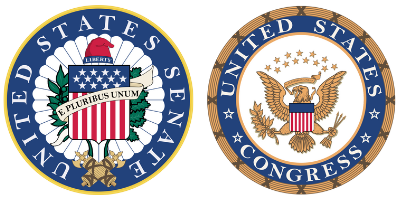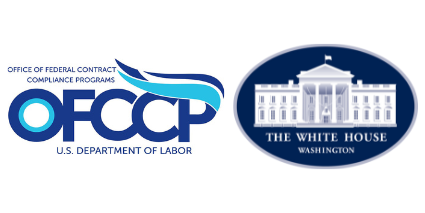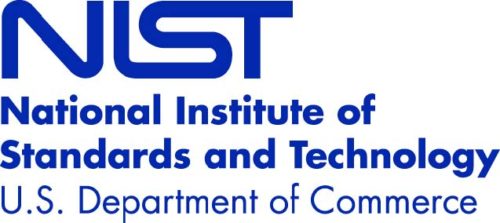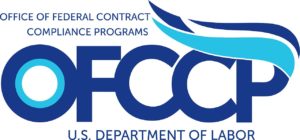 The DE OFCCP Week in Review (WIR) is a simple, fast and direct summary of relevant happenings in the OFCCP regulatory environment, authored by experts John C. Fox, Candee J. Chambers and Cynthia L. Hackerott. In today’s edition, they discuss:
The DE OFCCP Week in Review (WIR) is a simple, fast and direct summary of relevant happenings in the OFCCP regulatory environment, authored by experts John C. Fox, Candee J. Chambers and Cynthia L. Hackerott. In today’s edition, they discuss:
- Senate HELP Committee Advanced Nominations for Kotagal as EEOC Commissioner & Looman as WHD Head
- OFCCP Leadership Shake-Up: Director Yang and Her Deputy Have Left OFCCP. No Successor Director Yet In Sight
- U.S. National Institute of Standards and Technology Launched Its Artificial Intelligence Resource Center
- VEVRAA Hiring Benchmark Dropped Slightly to 5.4%
- USCIS Updated Policy Guidance on Self-Selecting a Gender Marker on Benefits Forms & Documents
- OFCCP Held Uneventful Webinar Briefing on Religious Exemption Rule Rescission
- In Brief
- Looking Ahead: Upcoming Date Reminders
Tuesday, March 28, 2023: Senate HELP Committee Advanced Nominations for Kotagal as EEOC Commissioner & Looman as WHD Head

Last month, in a 12-9 vote, the Senate HELP Committee reported favorably on the nomination of Karla Gilbride for EEOC General Counsel. However, the Looman nomination hit a technical snag (see our story here). The HELP Committee resolved that snag with Tuesday’s vote. Accordingly, the Kotagal, Gilbride, and Looman nominations are teed up for full Senate floor votes. For more background on these three nominations, see our stories here and here.
Senate Floor Vote is Likely 3-4 Weeks Away, Though
It appears that Senate Majority Leader Chuck Schumer (D-NY) now has the 50 Democrat Senator votes needed to confirm on the Senate Floor all three of these previously stalled nominees. Otherwise, the HELP Committee would not have greenlighted them at this time. However, it may not be until mid-to-late April before Senator Schumer can round up the Democrats he needs to show up on the Floor of the Senate to vote. While Senator John Karl Fetterman (D-PA) is now out of the Walter Reed Hospital and is home recovering from a bout of severe depression, he is not expected back in the Senate, however, before April 17. Eighty-nine-year-old Senator Diane Feinstein (D-CA) is now also out of the hospital and is resting at home recovering from her severe attack of shingles but has not yet, as of this writing, announced when she will be able to return to the Senate.
The Importance of this Story is the Apparently Imminent Kotagal Confirmation
The importance of these Senate confirmations is Ms. Kotagal’s employee badge to the U.S. Equal Employment Opportunity Commission. Once sworn in to the five-member bi-partisan Commission, Democrats will for the first time in the Biden Administration have a 3-2 voting majority on the Commission. That has two primary implications for employers:
First, the Commission will then be able to issue policy statements purporting to “interpret” the statutes the Commission enforces. Regardless of what the policy interpretations state, they will now pass 3-2 with both Republican Commissioners in dissent. Experience with this Commission suggests that its future policy statements will seek to “stretch” traditional interpretations of Title VII, especially, to make it mean different things. One is immediately reminded in fact of Lewis Carrol’s famous writing in his 1872 masterpiece Through the Looking-Glass:
“When I use a word,” Humpty Dumpty said, in rather a scornful tone, “it means just what I choose it to mean—neither more nor less.” “The question is,” said Alice, “whether you can make words mean so many different things.” “The question is,” said Humpty Dumpty, “which is to be master—that’s all.”
Second, very soon after Ms. Kotagal’s arrival at the EEOC, the Commission will seek to publish (over the dissenting votes of both Republican Commissioners) a new EE0-1 Component 2 “Hours Worked and Pay Data” reporting requirement applicable to all employers Title VII covers and employing 100 or more employees. Before the Commission, however, puts its “cart before its horse,” the first question it must consider is whether the Commission will submit its Component 2 pay data reporting proposal to the Administrative Procedure Act’s (“APA”) public Notice and Comment procedures, as it should for at least four reasons:
- The APA Requires It: This is not a procedural rule of practice which may avoid formal Rulemaking. Rather the Commission’s Rule would have a substantial impact on the regulated community. Indeed, former EEOC Chair Janet Dhillon reported that the EEOC’s prior one-time Component 2 reporting requirement cost employers almost 3/4s of a Billion Dollars to comply and took almost 9 months for 80% of covered employers to eventually find, organize, correct and report data responsive to the Commission’s requirements; and
- The EEOC Will Legally Doom Its Pay Data Reporting Tool Absent APA Rulemaking: Failure to follow APA Rulemaking procedures has cost this Administration several policy objectives it rushed through too quickly without proper Rulemaking (most notably the legal disasters the federal courts nationwide handed the Biden vaccination policies (with the SCOTUS upholding the one vaccination mandate which the White House did subject to APA Notice and Comment)). The lack of required Rulemaking has also cost this Administration prestige in the legal community left to wonder whether the Administration just does not properly understand Administrative law or whether it just does not care in its rush to assert its policy objectives. The APA was, after all, a product of the Roosevelt and Truman White Houses and primarily shaped and put forward by Roosevelt’s Attorney General.
- APA Rulemaking would Allow The Commission To Fashion A Better Pay Data Collection Tool: The Commission needs to hear from the public how to report what data both for improved efficient and economic collection and reporting of the data but also to allow the Commission to obtain meaningful data. There are so many questions the Commission must consider, including these just for starters:
- How should the “Hours worked” data be defined, organized and reported;
- How to accommodate hours worked data for exempt employees to insure an “apples to apples” comparison of employees (some of whom may work 40-hours a week and others might work 90-hours a week);
- Whether to report W-2 data or hours worked and corresponding pay data;
- How to report pay data when it is only one part of a multi-component “total compensation” package built on a salary, stock (Larry Ellison’s salary was $1 a year but he annually earned hundreds of millions of dollars in various kinds of stock allocations), bonuses (many tech companies have over a dozen kinds of incentive and reward bonus programs for employees), variable PTO offerings, etc.;
- How to report “similarly situated” employees (the baseline foundation of any unlawful discrimination investigation: otherwise the data are not meaningful) without excessive burden and while protecting the privacy of employees in small or one-contributor work groups?;
- Whether and how to report the “major” factors which affect pay, without which any compensation analysis it utterly flawed, as a matter of law;
- Whether to focus pay data reporting on job titles of potential concern to the Commission rather than universal reporting given the broad consensus that much lower level pay reporting scales are not of concern; and
- Whether to exempt reporting of the pay of unionized work groups where compensation is tied to seniority and thus immune from Title VII attack; and
- The Commission Will Not Obtain Employer “Buy In” If It Runs Through Caution Lights, Stop Signs and Runs Over Employers In Its Haste To Get Its Pay Data Reporting Rule Forward. A “just get ‘er done” mad-rush mentality will work to the Commission’s disadvantage. The employer community resisted and determinedly fought against the first Component 2 Hours Worked and Pay Data Reporting requirement for three primary reasons:
- The EEOC left employers out of the discussion about whether and how to deploy the reporting requirements. It thus appeared to employers that the pay data reporting was being forced down their gullets with no ability to participate, be heard and feel part of this new regulatory requirement, let alone help guide it to a meaningful design and use;
- To a company, everyone in the employer community, and reportedly all career staff at the EEOC and OFCCP, felt the Commission was collecting pay data with no utility to help the Commission and/or OFCCP pursue their respective agency missions. Indeed, post-collection EEOC and OFCCP reviews of the collected data have not reported any utility to the Commission or OFCCP. Similarly, the State of California’s Civil Rights Department has been silent on any appreciable benefits it has derived from the pay data reporting (modeled on the first EEOC pay data reporting requirements) it requires of California employers; and
- Employers not able to participate in a formal Rulemaking and experiencing a very burdensome reporting requirement few thought would have any utility to any government agency, realized that they were caught up in an activity that was merely a political event. Employers quickly realized that the pay reporting requirement was not to create and develop technical tools to help ferret out and combat compensation discrimination. Rather, employers quickly realized the whole exercise was merely a “White Knight” political event to help certain politicians tell women they were charging forward at full gallop and with sword in hand to protect them from unlawful employers. (NOTE: while 61% of women in the U.S. reportedly feel they are not properly paid, only 50% of men feel that same way. So, there is something there for politicians to feed on. At the same time, fewer than typically 1,000 women per year file Charges with the EEOC claiming unlawful pay discrimination: i.e., typically far less than 2% of all (approximately 60,000 depending upon the year) discrimination Charges filed each year. Of those 1,000ish pay discrimination Charges, the EEOC typically finds only about 20% meritorious, i.e., typically only about 200-300 claims per year out of the almost two hundred million pay decisions made each year in the U.S.).
What The Commission Needs To Do To Obtain Employer Buy In and Build A Useful Pay Data Reporting Rule. It is thus painstakingly clear that unless the EEOC wants again widespread employer rejection of its pay dating reporting requirement, it needs to develop a multi-year plan to court, involve, and tap the thinking of employers to help knit together a meaningful reporting tool. Such a campaign would start with in-person Town Hall meetings throughout the country, dozens of private meetings with knowledgeable and interested stakeholders including employers, employees, and unions followed by a proposed Notice of Proposed Rulemaking to be followed by a Final Rule deployed as a “pilot” to test whether the new reporting requirements indeed collect meaningful data in an economically efficient manner.
Thursday, March 30, 2023: OFCCP Leadership Shake-Up: Director Yang and Her Deputy Have Left OFCCP. No Successor Director Yet In Sight
Move Took Effect March 31
Deputy Director (career employee) Michele Hodge Moved Up to Acting Director

A week before rumors began to spread about Director Yang’s departure, Maya Raghu, a political appointee reporting to the Director as the Deputy Director for Policy, suddenly announced her resignation, without explanation and with no next destination in hand. Ms. Raghu has been at OFCCP for less than two years (since July 19, 2021). It is not uncommon, though, for political appointees to arrive and depart together since they support each other as a team at the agency to which they are assigned.
As happens when there are no political appointees left at a federal agency to lead it, the senior career employee of the agency is typically appointed as an interim “Acting” Director. (This happens every time a new President moves into the White House, for example. A career employee fills in during the interregnum between the outgoing political team and the soon-incoming political team.)
Accordingly, Acting Secretary of Labor Julie Su appointed last week OFCCP Deputy Director Michele Hodge to serve as OFCCP’s Acting Director until the Secretary of Labor appoints a new political employee to be the agency’s “Director” if she does. While the situation is very fluid at USDOL and OFCCP with so many sudden and unexpected departures from the Department in such close succession, it was unclear whether Acting Secretary Su would appoint a new political employee to be the next “Director” of the OFCCP.
Since Acting Secretary Su is herself awaiting both a Senate Health, Education, Labor and Pensions (H.E.L.P.) Committee nomination Hearing to be the next Secretary of Labor, and if successful, thereafter a full floor Senate confirmation vote, it is highly likely that Secretary Su will take NO ACTION on the OFCCP Director position. Rather, Secretary Su will most likely “narrow her target profile” in the Senate by making no decision until she is safely confirmed and sitting in the big chair in the Secretary of Labor’s office overlooking Capitol Hill.
Director Yang’s formal resignation announcement on Thursday did not come as a surprise. Buzz began circling on Monday about Yang’s pending change in Biden Administration roles. By Wednesday, a sprinkling of news outlets reported the planned move based on various sources within the Administration.
It is unusual for political appointees to leave their assignment mid-term during a President’s 4-year term. Director Yang’s departure comes at a time, however, of much turmoil within the USDOL and OFCCP. Secretary of Labor Marty Walsh left his post early too (March 11, 2023) in a snit when President Biden passed him over to be the President’s Chief of Staff at The White House. It is a real affront to a President to have a Cabinet Member leave the President’s Administration mid-term. At the same time, OFCCP is coming off two of the worst years of its performance in the agency’s history. Moreover, the agency has been noticeably struggling in recent months to perform its basic service functions for the public without error and redoes.
Yang joined OFCCP as its Director on January 20, 2021. From 2013-2018, she served in Obama Administration as a Commissioner of the U.S. Equal Employment Opportunity Commission (EEOC). She was EEOC Vice-Chair in 2014, then EEOC Chair from September 1, 2014, until January 25, 2017. Following that, she was a Senior Fellow at the Urban Institute. In her new role, Yang will “work on a broad range of issues, including equal opportunity in employment, criminal justice, democracy and voting, disability policy, Native Affairs, [and the] racial wealth gap,” she said in her email.
Thursday, March 30, 2023: U.S. National Institute of Standards and Technology Launched Its Artificial Intelligence Resource Center
Center Includes AI Risk Management Framework Playbook

Because the use of AI tools is a highly technical subject, we sought out the views about the NIST announcement of Athena Karp, Founder and CEO of HiredScore, an artificial intelligence HR technology company that powers the global Fortune 500. Ms. Karp, an advocate within the AI developer community for transparency and the ethical development of AI tools, as well as a strong proponent for cross-stakeholder collaboration including government, employers, legal experts, users of the tools, and non profits, told the WIR she welcomed NIST’s announcement:
“We are excited to see the continued commitment by the US government to ensure responsible and trustworthy AI and alignment with International standards. Importantly, this work calls out the differentiation of AI risks from traditional software and systems of record to ensure buyers and users have dedicated frameworks for the use of AI, including evaluation, cross stakeholder accountability, and best practices to ensure our industry continues to safely innovate.“
According to NIST, the AIRC will help implement trustworthy and responsible approaches such as those described in NIST’s AI Risk Management Framework (AI RMF) we earlier discussed here. The voluntary AI RMF offers guidance to address the key building blocks of trustworthy AI for its creators to better manage risks to individuals, organizations, and society associated with AI tools.
NIST intends to expand the initial version of the AIRC over time based on contributions from NIST and others. It includes the AI RMF 1.0 and the first complete version of the companion Playbook. Users can now filter content in the AI RMF Playbook by AI RMF function, topic, and AI actor role so that they may quickly isolate relevant information most useful to them.
The AIRC also includes:
- access to a standards tracker about AI standards around the globe, along with a metrics hub to assist in testing, evaluation, verification, and validation of AI;
- a beta format version of a trustworthy and responsible AI Glossary (NIST plans to produce a final glossary later based on community input); and
- a repository for NIST technical and policy documents related to the AI RMF, the NIST AI publication series, as well as NIST-funded external resources in the area of trustworthy and responsible AI.
Friday, March 31, 2023: VEVRAA Hiring Benchmark Dropped Slightly to 5.4%
Steady benchmark decline continued
Time to Update VEVRAA AAPs

The following table shows the decline of the benchmark since 2020:
National Annual Veteran Hiring Benchmark
| National Percentage of Veterans | |
| Effective Date Range | National Percentage of Veterans in the Civilian Labor Force |
| 03/31/2023 – | 5.4% |
| 03/31/2022 – 03/30/2023 | 5.5% |
| 03/31/2021 – 03/30/2022 | 5.6% |
| 03/31/2020 – 03/30/2021 | 5.7% |
What Does the Benchmark Mean for OFCCP AAP Compliance?
The VEVRAA Hiring Benchmark is NOT the unemployment rate of Protected Veterans. Rather, it is the approximate percentage of Protected Veterans in the civilian workforce at the time of publication. OFCCP set the benchmark pursuant to its regulations at 41 CFR §60-300 that implement the Vietnam Era Veterans’ Readjustment Assistance Act (VEVRAA) as revised in 2013, effective March 24, 2014.
Among other obligations, the regulations at §60-300.45 provide that covered contractors must set, for each of their establishments, annual hiring benchmarks for protected veterans, either based on the national percentage of veterans in the workforce or an individualized benchmark based on five factors described in 41 CFR §60-300.45(b)(2). For those (very few) contractors who chose to calculate an individualized hiring benchmark, OFCCP also updated the state-level veteran availability data on its VEVRAA Hiring Benchmark webpage (click on “Option II: Develop Individualized Hiring Benchmark”).
The benchmark applies only to hiring data applied in federal contractors’ Affirmative Action Plans (AAPs). OFCCP has consistently said that failing to meet the benchmark is not a violation of its Rules and will not carry any penalties. Rather, contractors should use the result of this comparison when assessing the effectiveness of their veteran outreach and recruitment efforts to determine if further efforts are necessary.
For additional background, see our blog from 2019: VEVRAA Benchmark for Hires: How Much Do You Really Know About this Percentage and Its Meaning?
Friday, March 31, 2013: USCIS Updated Policy Guidance on Self-Selecting a Gender Marker on Benefits Forms & Documents
Proof of Gender Identity Not Required for Most Forms

The update also clarified that individuals requesting benefits do not need to submit proof of their gender identity when submitting a request to change their gender marker, except for those submitting Form N-565, Application for Replacement Naturalization/Citizenship Document. The guidance in this Policy Manual section does not currently apply to Form N-565, and individuals submitting this form must continue to follow the form instructions USCIS reported. (See, 8 CFR 103.2(a)(1)).
What About Those Who Want to Change Their Marker After Their Initial Filing?
Those seeking to change their gender marker following their initial filing should refer to the Updating or Correcting Your Documents webpage. Currently, the only gender markers available are “Male” (M) or “Female” (F). The U.S. Department of Homeland Security (“DHS”) is working on options to include an additional gender marker (“X”) for another or unspecified gender identity. USCIS will update its forms and the Policy Manual accordingly.
Feedback – Both Past & Continuing
In April 2021, DHS published a Request for Public Input (with correction here) seeking the public’s feedback on barriers to USCIS benefits and services. Responses to this request indicated that the evidentiary requirements associated with gender marker changes created barriers for individuals requesting immigration benefits, USCIS reported. Through subsequent listening sessions with DHS, stakeholders have further highlighted how this policy change will remove barriers and reduce burdens for applicants and petitioners, the agency added.
Moreover, USCIS welcomes feedback on this updated policy manual guidance and will consider any comments received in future updates. Visit the Policy Manual Feedback page to comment on this update.
Friday, March 31, 2023: OFCCP Held Uneventful Webinar Briefing on Religious Exemption Rule Rescission
No Specific Process for Contractors to Obtain Exemption

Sarah Carson, Senior Regulatory Analyst with OFCCP’s Division of Policy and Program Development, Marla Tumiel, OFCCP Compliance Officer, and Deputy Director Michele Hodge, who became Acting OFCCP Director on April 1, spoke first. They essentially carefully repeated what the agency stated in its Federal Register notice of March 1, 2023.
Tumiel also reiterated the information contained in Question Five of OFCCP’s FAQs on the Final Rule regarding what contractors should do to obtain the exemption. The answer to Question 5 states:
“There is no specific process to request an exemption from OFCCP. Whether the religious exemption applies is a highly fact-specific inquiry that depends on the particular employment scenario at issue. If the contractor is presently under review, the contractor may notify the OFCCP compliance officer (CO) that it requests a religious exemption. Outside the context of a compliance evaluation or complaint investigation, OFCCP is committed to providing compliance assistance to contractors with questions about their obligations and offers a variety of ways to contact the agency to seek that assistance.”
Jonide Corbin, Branch Chief for Regulatory and Legislative Development with OFCCP’s Division of Policy and Program Development, and Anna Laura Bennett, an attorney with the U.S. Department of Labor’s Office of the Solicitor, joined the webinar for the uneventful Q&A portion.
In Brief
Friday, March 31, 2023: OFCCP Opened AAP Certification Contractor Portal with June 29 Deadline

In a March 31 email to stakeholders, OFCCP reported that it had added a new data requirement – the agency is asking Contractors to record reporting the AAPs coverage period(s). OFCCP now wants contractors to provide the start date of their AAP compliance when certifying their AAP Establishment pages. The agency also posted a pre-recorded updated webinar to the Contractor Portal information page that demonstrates how contractors can enter their establishment and/or functional/business unit’s AAP start date and certify compliance through the Contractor Portal.
Looking Ahead:
Upcoming Date Reminders
December 2022: U.S. DOL WHD’s (now overdue) target date to publish a Notice of Proposed Rulemaking to Analyze Public Comments on its proposed rule regarding Nondisplacement of Qualified Workers Under Service Contracts (RIN: 1235-AA42)
December 2022: U.S. OSHA’s (now overdue) target date to publish its Final Rule on Occupational Exposure to COVID-19 in Healthcare Settings (RIN: 1218-AD36) (OSHA submitted this Final Rule to OMB on December 7, 2022)
December 2022: U.S. DOL’s OASAM’s (now overdue) target date to publish Proposed Rule on “Revision of the Regulations Implementing Section 188 of the Workforce Innovation and Opportunity Act (WIOA) to Clarify Nondiscrimination and Equal Opportunity Requirements and Obligations Related to Sex” (RIN: 1291-AA44)
February 2023: U.S. DOL WHD’s (now overdue) target date for its Final Rule on Updating the Davis-Bacon and Related Acts Regulations (RIN: 1235-AA40)
March 2023: OFCCP’s (now overdue) target date for its Notice of Proposed Rulemaking to Require Reporting of Subcontractors (RIN: 1250-AA15)
March 2023: OFCCP’s (now overdue) target date for its Final Rule on Pre-Enforcement Notice & Conciliation Procedures (RIN: 1250-AA14)
March 2023: OFCCP’s (now overdue) target date for its Final Rule on “Technical Amendments” to Update Jurisdictional Thresholds & Remove Gender Assumptive Pronouns (RIN: 1250-AA16)
April 2023: OFCCP’s target date for its Notice of Proposed Rulemaking to “Modernize” Supply & Service Contractor Regulations (RIN: 1250-AA13)
Monday, April 3, 2023 (at 2 pm ET): DE Webinar |Creating Inclusive Virtual Apprenticeship Programs & More Accessible Workplaces – Register here
Friday, April 7, 2023: Comments due on OFCCP’s request to extend, without change, VEVRAA information collection requirements – https://www.regulations.gov/commenton/DOL_FRDOC_0001-2057
Wednesday, April 12, 2023: Comments due on the Office of Management & Budget’s “Initial Proposals for Updating Race and Ethnicity Statistical Standards” – https://www.regulations.gov/commenton/OMB-2023-0001-0001
Wednesday, April 12 – Friday, April 14, 2023: DEAMcon23 Chicago (Registrations open now; Agenda now available here!)
Wednesday, April 19, 2023: Deadline to submit comments on FTC proposal to ban employers from implementing most worker non-compete agreements (previous March 20 deadline extended) – https://www.regulations.gov/commenton/FTC-2023-0007-0001
Thursday, April 20, 2023 (at 2 pm ET): DE Masterclass Employment Law Roundtable | OFCCP Contractor Portal Issues – Register here
Friday, April 21, 2023: Comments due on OFCCP’s proposed changes to its disability self-identification form (the proposed revised form is here) – https://www.regulations.gov/commenton/DOL_FRDOC_0001-2063
Monday, April 24, 2023: Comments due on USDOL Wage & Hour Division’s Proposal to Revise Existing WD-10 Form for Federal Construction Contractors – https://www.regulations.gov/commenton/DOL_FRDOC_0001-2065
Sunday, April 30, 2023: Deadline to apply for 2023 HIRE Vets Medallion Award Program – https://www.hirevets.gov/
May 2023: U.S. DOL WHD’s target date for its Notice of Proposed Rulemaking on Defining and Delimiting the Exemptions for Executive, Administrative, Professional, Outside Sales and Computer Employees (RIN: 1235-AA39)
May 2023: U.S. DOL WHD’s target date for its Final Rule on Employee or Independent Contractor Classification Under the Fair Labor Standards Act (RIN: 1235-AA43)
Tuesday, May 9, 2023: Public comment deadline on FTC’s “Request for Information” on franchise agreements and franchisor business practices – https://www.regulations.gov/commenton/FTC-2023-0026-0001
Thursday, June 29, 2023: Deadline for covered federal contractors and subcontractors to certify, via OFCCP’s online Contractor Portal, that they have developed and maintained affirmative action programs for each establishment or functional unit – https://www.dol.gov/newsroom/releases/ofccp/ofccp20230320
August 2023: U.S. NLRB’s target date for its Final Rule on Standard for Determining Joint-Employer Status (under the NLRA) (RIN: 3142-AA21)
August 2023: U.S. NLRB’s target date for its Final Election Protection Rule (RIN: 3142-AA22)
THIS COLUMN IS MEANT TO ASSIST IN A GENERAL UNDERSTANDING OF THE CURRENT LAW AND PRACTICE RELATING TO OFCCP. IT IS NOT TO BE REGARDED AS LEGAL ADVICE. COMPANIES OR INDIVIDUALS WITH PARTICULAR QUESTIONS SHOULD SEEK ADVICE OF COUNSEL.
SUBSCRIBE.
Compliance Alerts
Compliance Tips
Week In Review (WIR)
Subscribe to receive alerts, news and updates on all things related to OFCCP compliance as it applies to federal contractors.
OFCCP Compliance Text Alerts
Get OFCCP compliance alerts on your cell phone. Text the word compliance to 55678 and confirm your subscription. Provider message and data rates may apply.

